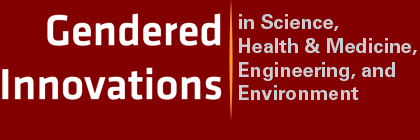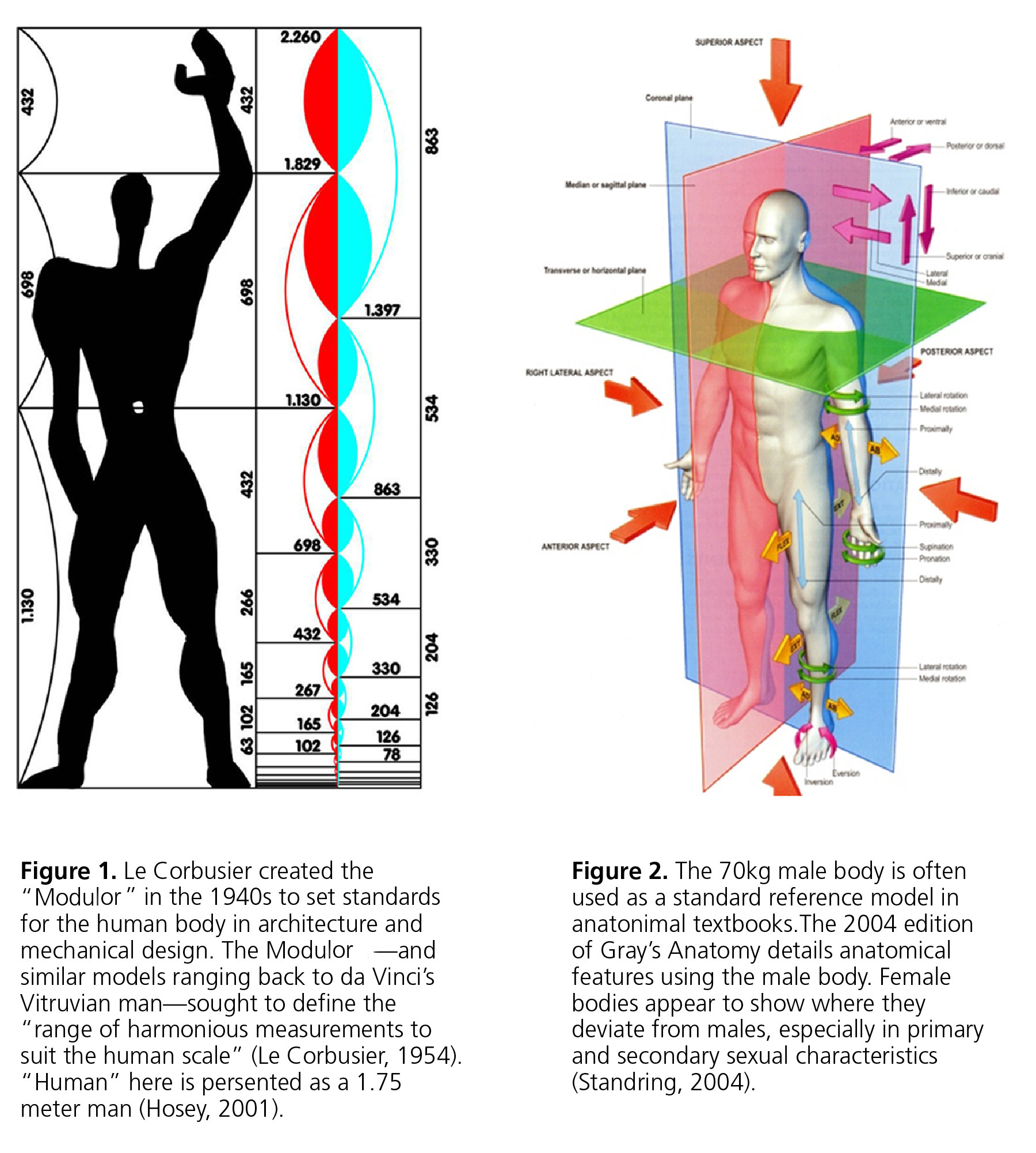Sex & Gender Analysis
Case Studies
- Science
- Health & Medicine
- Chronic Pain
- Colorectal Cancer
- Covid-19
- De-Gendering the Knee
- Dietary Assessment Method
- Gendered-Related Variables
- Heart Disease in Diverse Populations
- Medical Technology
- Nanomedicine
- Nanotechnology-Based Screening for HPV
- Nutrigenomics
- Osteoporosis Research in Men
- Prescription Drugs
- Systems Biology
- Engineering
- Assistive Technologies for the Elderly
- Domestic Robots
- Extended Virtual Reality
- Facial Recognition
- Gendering Social Robots
- Haptic Technology
- HIV Microbicides
- Inclusive Crash Test Dummies
- Human Thorax Model
- Machine Learning
- Machine Translation
- Making Machines Talk
- Video Games
- Virtual Assistants and Chatbots
- Environment
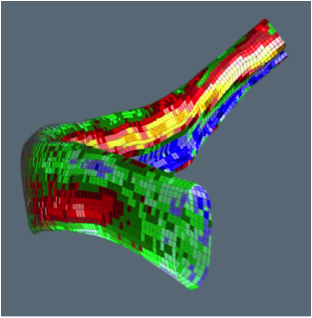
Human Thorax Model: Rethinking Standards and Reference Models
The Challenge
Biofidelic models are critical tools in improving automobile occupant safety. They are used by engineers, manufacturers, and governmental agencies. The HUman MOdel for Safety (HUMOS-1), funded under the Fourth EC Framework Programme (FP4) from 1997 to 2000, was based on the study of a single male cadaver, representing "a 50th percentile seated man" (Pajon et al., 2002). HUMOS-2, funded under the Fifth EC Framework Programme (FP5) from 2002 to 2006, collected anthropometric data from humans of the 5th, 50th, and 95th percentiles of overall weight, which is more inclusive of lighter people (mostly women) and heavier people (mostly men) (Toma et al., Acart et al., 2009a; Dupont-Kerlan et al., 2006). Biofidelic models are often developed first for the 50th percentile man, excluding people who are significantly smaller or larger.
Method: Rethinking Standards and Reference Models
Models of the human body have long been based on the anthropometry of 50th percentile European and North American men (see Case Study: Pregnant Crash Test Dummies). Researchers are rethinking this standard and studying a wider range of women's and men's bodies in order to produce more advanced and representative human body models.
Gendered Innovations:
1. Modeling Women's and Men's Thoraxes THOMO researchers are developing a model of the human thorax applicable to the majority of women and men.
2. Consistent Biomechanical Testing across Female and Male Thoraxes
Potential Value Added to Future Research through the Application of Gendered Innovations Methods:
1. Studying the Effects of Age and Menopausal Status on Thoracic Bone Architecture
2. Including Geographically Diverse Populations 3. Modeling Breast TissueBackground: The European Union Framework Programme 7 (FP7) Thorax Model (THOMO) project
Gendered Innovation 1: Modeling Women's and Men's Thoraxes
Method: Rethinking Research Priorities and Outcomes
Gendered Innovation 2: Consistent Biomechanical Testing across Female and Male Thoraxes
Method: Rethinking Standards and Reference Models
Potential Value Added to Future Research through the Application of Gendered Innovations Methods
Potential Value Added 1: Studying the Effects of Age and Menopausal Status on Thoracic Bone Architecture
Method: Intersectional Approaches
Potential Value Added 2: Including Geographically-Diverse Populations
Method: Intersectional Approaches
Potential Value Added 3: Modeling Breast Tissue
Method: Formulating Research Questions
The Challenge
Road traffic collisions are a major cause of mortality and morbidity in the European Union and the U.S.; in 2009, collisions resulted in an estimated 34,500 deaths in the EU-27 and 30,862 deaths in the U.S. (Eurostat, 2011; NHTSA, 2012). Deaths are also concentrated among men. In both the EU and U.S., men are 2.6 times as likely as women to die in road collisions (DG Energy and Transport, 2009; Kposowa et al., 2009).
Multiple research projects have been undertaken with the goal of developing a finite-element model of the human body to enhance safety engineering. Consistently, models have been initially based on 50th percentile male anthropometry, with some models later expanded to include larger and smaller bodies (Yang et al., 2006). Following this pattern, the Human Model for Safety (HUMOS-1), funded under the EC Fourth Framework Programme (FP4) from 1997 to 2000, was based on the study of a single male cadaver, representing "a 50th percentile seated man" (Pajon et al., 2002).
HUMOS-2, funded under the EC Fifth Framework Programme (FP5) from 2002 to 2006, expanded data collection to include humans from the 5th, 50th, and 95th percentiles,—i.e., lighter people (mostly women) and heavier people (mostly men) (Toma et al., 2010; Acart et al., 2009a; Dupont-Kerlan et al., 2006). Biofidelic models are, however, still developed first for the 50th percentile man, from the outset excluding people who are significantly smaller or larger. One such example is the Global Human Body Models Consortium (GHMBC) model (GHMBC, 2012).
Background
The European Union Framework Programme 7 (FP7) Thorax Model (THOMO) project aims to develop a numerical, "finite element model of the human thorax and upper extremities" (THOMO, 2012). Data-gathering procedures by THOMO and associated research teams can be sorted into two basic categories:
- A. Measurement of the thoracic skeleton (imaging of ribs, sternum, vertebrae, and cartilage) with computed tomography (CT), laser scans, and microtomography (μCT) (Mayeur et al., 2010).
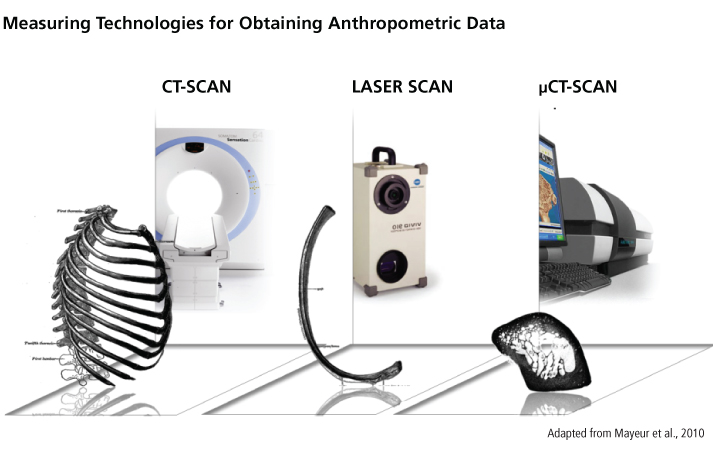
- B. Biomechanical stress tests on cadaver ribcages. Dynamic test endpoints include deformation under strain and actual fractures.
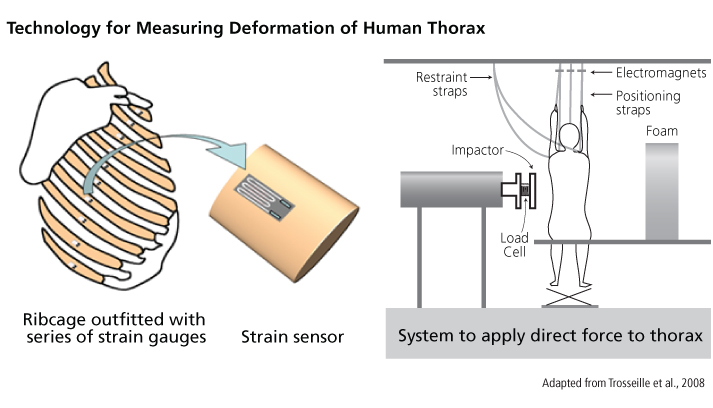
THOMO project measurements and biomechanical tests are performed on cadavers from France corresponding to the following percentiles of overall human body weight:
- 50th (11 male cadavers and 1 female cadaver)
- 5th (6 female cadavers)
THOMO uses scaling to model other size percentiles (THOMO, 2012).
THOMO is one of four biomechanical modeling projects under the EU's Coordination of Vehicle and Road Safety Initiatives (COVER) consortium. All COVER projects are funded under FP7 and each has a distinct focus (Lemmen et al., 2009) - see diagram:
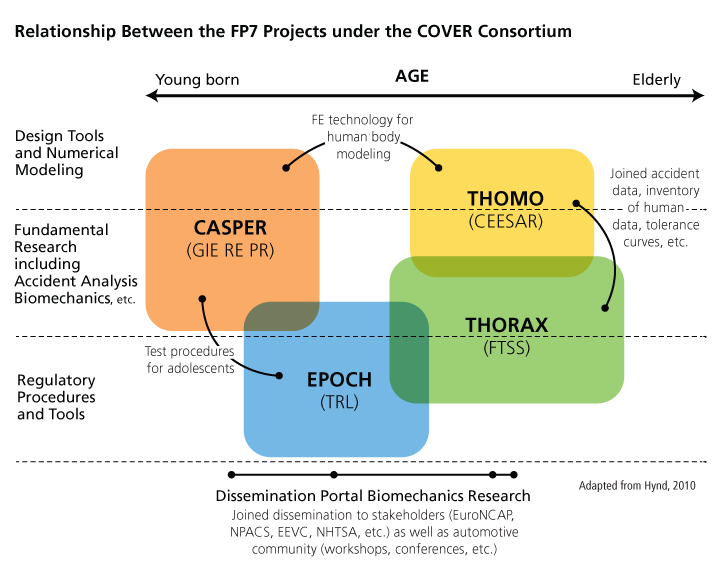
The THOMO project is one of several Centers of Expertise for the privately funded Global Human Body Models Consortium (GHMBC), which consists of nine automobile manufacturers from EU countries, the U.S., South Korea, and Japan, as well as the U.S. National Highway Traffic Safety Administration (NHTSA) (GHBMC, 2012).
Automotive manufacturers continue to develop finite-element models for safety engineering purposes (Leonardi, 2009). One example is the Total Human Model for Safety (THUMS), a proprietary project of the Toyota Motor Corporation (Maeno et al., 2001). The initial version of THUMS was based on anthropometry of a 50th percentile U.S. man (Chawala et al., 2005; Oshita et al., 2002). Currently, engineers are expanding the model to include 5th percentile American women, 95th percentile American men, and pregnant women (Iwamoto et al., 2007).
Gendered Innovation 1: Modeling Women's and Men's Thoraxes
The THOMO project models both women's and men's thoraxes by gathering data from bodies ranging from the 5th to 50th weight percentiles (THOMO, 2012).
Method: Rethinking Research Priorities and Outcomes
Studies of crash outcomes show that women drivers are approximately 47% more likely than men drivers to sustain severe injuries in automotive crashes when researchers control for factors such as height, weight, seatbelt usage, and crash intensity; that is to say, a seatbelt-wearing woman driver involved in a crash is more likely to be injured than a seatbelt-wearing man driver of identical height, weight, and age involved in an identical crash (Dipan et al., 2011; Evans, 1999). Several sex and gender factors may influence observed differences in crash outcomes:
- 1. Injury threshold: Women have a lower average injury threshold than men for some mechanisms of injury, such as whiplash, but young men have a lower velocity injury threshold than young women (Talmor et al., 2010; Stemper et al., 2004).
- 2. Design: Women may have excess risk because "effectiveness of occupant safety devices is biased toward the male occupants" (Dipan et al., 2011).
- 3. Type of vehicle driven: In the U.S., where data are available, women tend to drive cars with higher safety ratings than do men (Ryb et al., 2010).
Gendered Innovation 2: Consistent Biomechanical Testing of Female and Male Thoraxes
THOMO researchers have performed tests on small, mostly female thoraxes while maintaining consistency with instrumentation and data-reporting protocols previously applied to mostly male thoraxes. This method allows cross-sex comparison of strain profiles and the development of a more comprehensive reference model.
Method: Rethinking Standards and Reference Models
Physical strain tests are critical to developing biofidelic models.
Historically, a 50th percentile male cadaver thorax was used as a reference in frontal impact tests in EU-supported crash testing (Behr et al., 2003). This reference model did not account for lighter people's anatomy, and researchers who developed it recommended further work to "develop injury risk functions for female and elderly" drivers and passengers (Carroll, 2010). 50th percentile models also leave out larger people, and researchers assessing the "injury reduction potential" of automotive safety research assert that "the use of a larger than average size dummy could lead to the greatest benefit" (Carrol et al., 2010). THOMO researchers have worked to expand reference models of the thorax beyond the 50th percentile to include 5th percentile human body sizes. In light of this, THOMO researchers have prioritized creating a biofidelic, scalable model that better reflects the anatomy of both women and men.
Potential Value Added to Future Research through the Application of Gendered Innovations Methods
Potential Value Added 1: Studying the Effects of Age and Menopausal Status on Thoracic Bone Architecture
Inter-individual variation in the thorax extends beyond size and sex differences. Factors such as age and menopausal status influence bone mineral density (BMD) and microarchitecture, consequently altering biomechanical properties.
Method: Intersectional Approaches
Factors relevant to the THOMO project include:
- 1. Age BMD increases slowly from birth to puberty, and rapidly for several years after puberty, before reaching a plateau extending into the 30s and then gradually declining with advancing age. There are sex differences in developmental BMD trends; for example, because puberty occurs earlier in women than men, women reach peak lumbar spine BMD earlier (at age 18-20) than men (at age 20-23) (Boot et al., 2010). Sex differences are also observed in BMD decline, which starts earlier in men but occurs more rapidly in women, particularly after menopause (Min et al., 2010; Li et al., 2003).
Both biomechanical experiments on cadavers and epidemiological studies of injury elucidate the relationship between age, BMD, and bone strength. Biomechanically, volumetric BMD is a strong predictor of fracture threshold (Diederichs et al., 2009). Epidemiologically, "a consequence of decreased skeletal and physiological resilience [with increasing age] is that trauma and its sequelae are among the top ten causes of death in the 65-and-over population, with motor vehicle crash […] being one of the most common sources of such trauma" (Gayzik et al., 2008).
For these reasons, performing biomechanical tests on female and male cadavers of various age groups may be relevant to developing the thorax model.
- 2. Menopausal Status In women, menopause results in both acceleration of BMD loss and changes in bone microarchitecture (Sowers et al., 2010; Müller, 2005). For these reasons, performing biomechanical tests with bones from both pre- and post-menopausal female cadavers may increase the THOMO's biofidelity for a broader population.
These factors may be challenging to analyze because of limited availability of cadavers, and limited resources. If they cannot be fully incorporated into the THOMO model during development, they may be considered during validation.
Potential Value Added 2: Including Geographically Diverse Populations
The size percentiles used by THOMO researchers reflect body weight. Although sex differences in average body weight exist, sex is not the only predictor of weight—nor, necessarily, the most important. Body weight differs by country, and studying diverse cadavers may broaden the applicability of THOMO.
Method: Intersectional Approaches
Systematic comparisons of body weight between countries are challenging. Most databases report body mass index (BMI), not body weight itself because BMI is a better indicator of the epidemiology of obesity and malnutrition (Finucane et al., 2011). Nevertheless, existing data do show substantial differences in body weight between countries, and country differences can be larger than sex differences. For example: The average U.S. man weighs 16% more than the average U.S. woman (Ogden et al., 2004): the average Korean man weighs 21% more than the average Korean woman (Nam-Kyu, 2009). Assuming equal sex ratios in the U.S. and Korea, the average U.S. person weighs 29% more than the average Korean person. In fact, the average U.S. woman weighs more (74 kilograms) than the average South Korean man (69 kilograms) (Nam-Kyu, 2009; Ogden et al., 2004).
Potential Value Added 3: Modeling Breast Tissue
Researchers may enhance biofidelic models by examining research questions about the significance of breast tissue in automotive collision injury.
Method: Formulating Research Questions
Breast tissue is significant in two ways: first direct injury to the breast; second, differences in seatbelt positioning that may have broad effects on crash safety.
- A. Injury of the Breasts in Automotive Collisions
B. Breasts and Seatbelt Positioning
Seatbelt usage greatly increases occupant safety in a crash, but compressive and shearing stresses produced by three-point seatbelts can cause specific chest injuries, including damage to breast tissue, though these are rare (Paddle et al., 2009). Breast tissue injuries range in severity from mild crush injuries with bruising to severe breast trauma involving avulsion of the breast from the chest wall and internal hemorrhaging due to rupture of intracostal blood vessels (Paddle et al., 2009).Breast injury is of particular concern in nursing women, as it can cause milk ducts to rupture (Sircar et al., 2010). Specific concerns also apply to women with breast implants (Gatta et al., 2006).
Injury to soft tissue in the breast area is not unique to women. Cases of Mondor's disease—caused by damage to veins in the chest wall—have been reported in both women and men subsequent to crashes in which the patient was wearing a seatbelt (Gatta et al., 2006).
Some women may wear seatbelts improperly because of discomfort caused by the placement of the shoulder harness over the breasts. Improper seatbelt usage greatly increases overall injury risk in a crash (Nordhoff, 2005).During pregnancy, "anthropomorphic changes occur throughout the body and are not limited to the abdominal region," and changes in breast size "are particularly important because they can influence the fit and positioning of the seatbelt" (Acar et al., 2009). Seatbelt designs that accommodate abdominal depth up to 95th percentile non-pregnant women fail to account for the 62% of third-trimester pregnant women who have greater abdominal depths (Acar et al., 2009a). Researchers are actively developing finite-element models to improve automotive safety for pregnant women (Acar et al., 2009b) (see Case Study: Pregnant Crash Test Dummies).
Works Cited
Acar, B., Weekes, A., & Van Lopik, D. (2009a). 'Expecting': Occupant Model Incorporating Anthropometric Details of Pregnant Women. International Journal of Vehicle Design, 51 (3-4), 374-385.
Acar, B., & Van Lopik, S. (2009b). Computational Pregnant Occupant Model, 'Expecting,' for Crash Simulations. Journal of Automobile Engineering, 223 (7), 891-902.
Anderson, P. (2008). Reducing Drinking and Driving in Europe. Hamm: Deutsche Hauptstelle für Suchtfragen e.V. (DHS)
Banerjee, A. (1989). Seat Belts and Injury Patterns: Evolution and Present Perspectives. Postgraduate Medical Journal, 65 (762), 199-204.
Basic Research in Industrial Technologies for Europe (BRITE) - European Academy of Management (EURAM). (2001). Research: Making a Lasting Impression on Europe.
Behr, M., Arnoux, P., Serre, T., Bidal, S., Kang, H., Thollon, L., Cavallero, C., Kayvantash, K., & Brunet, C. (2003). A Human Model for Road Safety: From Geometrical Acquisition to Model Validation with Radioss. Computer Methods in Biomechanics and Biomedical Engineering, 6 (4), 263-273.
Boot, A., de Ridder, M., Van Der Sluis, I., Van Slobbe, I., Krenning, E., & de Muinck Keizer-Schrama, S. (2010). Peak Bone Mineral Density, Lean Body Mass, and Fractures. Bone, 46 (2), 336-341.
Chawala, A., Mukherjee, S., Mohan, D., & Jain, S. (2005). Validation of the Cervical Spine Model in THUMS. New Delhi: Indian Institute of Technology.
Ciarlet, P., & Ayache, N. (Eds.) (2004). Handbook of Numerical Analysis, Volume XII: Computational Models for the Human Body. Amsterdam: Elsevier.
Cummings, P. (2002). Association of Driver Air Bags with Driver Fatality: A Matched Cohort Study. British Medical Journal, 324 (7346), 1119-1122.
Department of Trade and Industry (DTI). (1998). AdultData: The Handbook of Adult Anthropometric and Strength Measurements - Data for Design Safety. London: United Kingdom DTI.
Geometrical Acquisition to Model Validation with Radioss. Computational Methods in Biomechanics and Biomedical Engineering, 6 (4), 263-273.
Bell, S., Mederios-Ward, N., & Strayer, D. (2011). "Feminine Gender Role Constructs and Aggressive Driving Behaviors." Proceedings of the 55th Annual Meeting of the Human Factors and Ergonomics Society, September 19th-23rd, Las Vegas.
Carrol, J., Smith, S., Richards, D., & Ganu, C. (2010). Estimate of Injury Reduction Potential for Different Occupant Sizes and Ages, and Total Benefit Expected to Arise from the Project. Brussels: European Commission. PDF
Carroll, J. (2010). "Thoracic Injury Assessment for Improved Vehicle Safety: Frontal Impact Information." 13th Annual Meeting of the Global Road Safety Partnership (GRSP) Informal Group on Frontal Impacts, June 27th, Paris.
Diederichs, G., Link, T., Kentenich, M., Schwieger, K., Huber, M., Burghardt, A., Majumdar, S., Rogalla, P., & Issever, A. (2009). Assessment of Trabecular Bone Structure of the Calcaneus using Multi-Detector CT: Correlation with μCT and Biomechanical Testing. Bone, 44 (5), 976-983.
Dipan, B., Segui-Gomez, M., & Crandall, J. (2011). Vulnerability of Female Drivers Involved in Motor Vehicle Crashes: An Analysis of US Population at Risk. American Journal of Public Health, 101 (12), 2368-2373.
Dupont-Kerlan, E., Guyot, H., Josefson, L., Gubbi, F., Arnadeau, F., Laurent, M., Funk, H., Chaillou, V., Rams, J., Pries, H., Aumuller, D., Jacques, G., Folkesson, H., & Klumper, T. (2006). Human Model for Safety 2 (HUMOS 2) Project.
European Road Safety Observatory (ERSO). (2010a). Traffic Safety, Basic Facts: Gender. Brussels: European Commission.
European Road Safety Observatory (ERSO). (2010b). Traffic Safety, Basic Facts: Motorcycles and Mopeds. Brussels: European Commission.
Evans, L. (1999). "Age Dependence of Female to Male Fatality Risk in the Same Crash: An Independent Reexamination." Proceedings of the 43rd Annual Meeting of the Association for the Advancement of Automotive Medicine, September 20-21, Barcelona.
European Union Directorate-General (DG) for Energy and Transport. (2009). Panorama of Transport. Brussels: European Commission.
Eurostat. (2011). Table TRSDR420: People Killed in Road Accidents. Brussels: European Commission.
Finucane, M., Stevens, G., Cowan, M., Danaei, G., Lin, J., Paciorek, C., Singh, G., Guitierrez, H., Lu, Y., Bahalim, A., Farzadfar, F., Riley, L., & Ezzati, M. (2011). National, Regional, and Global Trends in Body-Mass Index since 1980: Systematic Analysis of Health Examination Surveys and Epidemiological Studies with 960 Country-Years and 9.1 Million Participants. The Lancet, 377 (9765), 557-567.
Gatta, G., Pinto, A., Romano, S., Anacona, A., Scaglione, M., & Volterrani, L. (2006). Clinical, Mammographic, and Ultrasonographic Features of Blunt Breast Trauma. European Journal of Radiology, 59 (3), 327-330.
Global Human Body Models Consortium (GHMBC). (2012). Status of the GHMBC Project. PDF
Hayzik, F., Yu, M., Danelson, K., Slice, D., & Stitzel, J. (2008). Quantification of Age-Related Shape Change of the Human Rib Cage through Geometric Morphometrics. Journal of Biomechanics, 41 (7), 1545-1554.
Handel, N., Hayden, B., Jervis, W., & Maxwell, P. (2000). Revisions in Breast Augmentation. Aesthetic Surgery Journal, 20 (2), 141-148.
Hynd, D. (2010). THORAX Stakeholder Workshop Dummy Demonstrator Requirements. Brussels: European Commission.
Iwamoto, M., Nakahira, Y., Tamura, A., Kimpara, H., Watanabe, I., & Miki, K. "Development of Advanced Human Models in THUMS." Proceedings of the 7th European Livermore Software (LS-DYNA) User's Conference, May 29-30, Gothenburg.
Kim, S., Depue, L., Spence, L., & Reine, J. (2009). Analysis of Teenage Seat Belt Use: From the 2007 Missouri High School Seat Belt Survey. Journal of Safety Research, 40 (4), 311-316.
Kposowa, A., & Breault, K. (2009). Motor Vehicle Deaths Among Men: Marital Status, Gender, and Social Integration. International Journal of Men's Health, 8 (2), 129-142.
Lemmen, P., & Weide, M. (2009). Coordination of Vehicle and Road Safety Initiatives (COVER) Newsletter, Issue I. PDF
Leonardi, P. (2009). From Road to Lab to Math: The Co-Evolution of Technological, Regulatory, and Organization Innovations for Automotive Crash Testing. Social Studies of Science, 40 (2), 243-274.
Li, G., Braver, E., & Chen, L. (2003). Fragility versus Excessive Crash Involvement as Determinants of High Death Rates per Vehicle-Mile of Travel among Older Drivers. Accident Analysis and Prevention, 35 (2), 227-235.
Majeski, J. (2007). Shoulder Restraint Injury of the Female Breast. International Surgery, 92 (2), 99-102.
Mayeur O., Chaari F., Delille R., Guillemot H., & Drazetic, P. (2010). Virtual Human Thorax Model Reconstruction: From Medical Imaging to Finite Element Model. International Research Council on Biomechanics of Injury Conference. Hannover, Germany.
Min, J., Min, K., Paek, D., Kang, D., & Cho, S. (2010). Age Curves of Bone Mineral Density at the Distal Radius and Calcaneus in Koreans. Journal of Bone and Mineral Metabolism, 28 (1), 94-100.
Mroz, K., Bostrom, O., Pipkorn, B., Wismans, J., & Brolin, K. (2010). "Comparison of Hybrid III and Human Body Models in Evaluating Thoracic Response for Various Seat Belt and Airbag Loading Conditions." Proceedings of the International Research Council on the Biomechanics of Injury (IRCOBI) Conference, September 15-16, Hanover.
Müller, R. (2005). Long-Term Prediction of Three-Dimensional Bone Architecture in Simulations of Pre-, Peri-, and Post Menopausal Microstructural Bone Remodeling. Osteoporosis International, 16 (S2), S25-S35.
Myhre, A., Pohlman, T., & Dee, K. (2002). Hemorrhage into the Breast in a Restrained Driver After a Motor Vehicle Collision. American Journal of Roentgenology, 179 (3), 690.
Nam-Kyu, B. (2009). Average Korean Now Overweight. The Chosun Ilbo (English Edition)—Daily News from Korea, July 27.
Noordzij, P., Forke, E., Brendicke, R., & Chinn, B. (2001). Integration of Needs of Moped and Motorcycle Riders into Safety Measures. Brussels: European Commission.
Nordhoff, L. (2007). Biomechanics: A Primer for Motor Vehicle Collision Injuries. Plaintiff Magazine, November, ¬1-7.
Nordhoff, L. (2005). Motor Vehicle Collision Injuries: Biomechanics, Diagnosis, and Management. London: Jones and Bartlett Publishers International.
Ogden, C., Fryar, C., Carrol, M., & Flegal, K. (2004). Mean Body Weight, Height, and Body Mass Index, United States, 1960-2002. Centers for Disease Control (CDC) Advance Data from Vital and Health Statistics, 347, 1-18.
Oshita, F., Omori, K., Nakahira, Y., & Miki, K. (2002). "Development of a Finite Element Model of the Human Body." Proceedings of the 7th International Livermore Software (LS-DYNA) User's Conference, May 19-21, Dearborn, Michigan.
Paddle, A., & Morrison, W. (2009). Seat Belt Injury to the Female Breast: Review and Discussion of its Surgical Management. Australia, New Zealand (ANZ) Journal of Surgery, 80 (1-2), 71-74.
Pajon, M., Kallieris, D., Dejeammes, M., Thunnissen, J., Ostmann, M., Mack, P., Baldauf, H., Keflas, V., Lovsund, P., Reis, O., Chabert, L., Strehi, D., Eberhard, H., & Bonnoit, J. (2002). Geometric Data Base of a 50th Percentile Seated Man and 3D Reconstruction. Brussels: European Commission.
Pajon, M., Kallieris, D., Dejeammes, M., Thunnissen, J., Ostmann, M., Mack, P., Baldauf, H., Keflas, V., Lovsund, P., Reis, O., Chabert, L., Strehi, D., Eberhard, H., & Bonnoit, J. (2000). Human model for Safety.
Procher, V., & Vance, C. (2012). Heterogeneity in the Correlates of Motorized and Non-Motorized Travel in Germany – The Intervening Role of Gender. Social Science Research Network Ruhr Economic Paper 314.
Robin, S. (2001). "HUMOS: Human Model for Safety—A Joint Effort towards the Development of Refined Human-Like Car Occupant Models." United States Department of Maeno, T., & Hasegawa, J. (2001). Development of a Finite Element Model of the Total Human Model for Safety (THUMS) and Application to Car-Pedestrian Impacts. Aichi: Toyota Motor Corporation.
Ryb, G., Burch, C., Kerns, T., Dischinger, P., & Ho, S. (2010). Crash Test Ratings and Real-World Frontal Crash Outcomes: A Crash Injury Research Engineering Network (CIREN) Study. Trauma and Acute Care Surgery, 68 (5), 1099-1105.
Sircar, T., Mistry, P., Harries, S., Clarke, D., & Jones, L. (2010). Seat-Belt Trauma of the Breast in a Pregnant Woman Causing Milk-Duct Injury: A Case Report and Review of the Literature. Annals of the Royal College of Surgeons of England, 92 (5), W14-W15.
Sowers, M., Zheng, H., Jannausch, M., McConnell, D., Nan, B., Harlow, S., & Randolph, J. (2010). Amount of Bone Loss in Relation to Time around the Final Menstrual Period and Follicle-Stimulating Hormone Staging of the Transmenopause. Journal of Clinical Endocrinology and Metabolism, 95 (5), 2155-2162.
Stemper, B., Yoganandan, N., & Pintar, F. (2004). Gender- and Region-Dependant Local Facet Joint Kinematics in Rear Impact: Implications in Whiplash Injury. Spine, 29 (16), 1764-1771.
Talmor, D., Legedza, A., & Nirula, R. (2010). Injury Thresholds after Motor Vehicle Crash—Important Factors for Patient Triage and Vehicle Design. Accident Analysis and Prevention, 42 (2), 672-675.
Toma, M., Njilie, T., Ghajari, M., & Galvanetto, U. (2010). Assessing Motorcycle Crash-Related Head Injuries using Finite Element Simulations. International Journal of Simulation and Modeling, 9 (3), 143-151.
Transportation (US-DOT) National Highway Traffic Safety Administration (NHTSA) 17th International Technical Conference on the Enhanced Safety of Vehicles, June 4th-7th, Amsterdam, Paper # 297.
Tropiano, P., Thollon, L., Huang, R., Kayvantash, K., Poitout, D., & Brunet, C. (2004). Using a Finite Element Model to Evaluate Human Injuries: Application to the HUMOS Model in Whiplash Simulation. Spine, 29 (16), 1709-1716.
Trosseille, X., Baudrit, P., Leport, T., & Vallancien, G. (2008). Rib Cage Strain Pattern as a Function of Chest Loading Configuration. Stapp Car Crash Journal, 52, 205-231.
United States Department of Transportation (US-DOT) Federal Highway Administration (FHWA). (2007). Highway Statistics 2006: Licensed Drivers by Sex and Ratio to Population, Table DL-1C.
United States Environmental Protection Agency (US-EPA). (2009). Exposure Factors Handbook. Washington, D.C.: Government Publishing Office (GPO).
United States National Highway Traffic Safety Administration (NHTSA). (2012). Fatality Analysis Reporting System (FARS) Encyclopedia.
Verriest, J. (2006). Achievements of HUMOS2 project (Human Model for Safety). Washington, D.C.: National Academies Press Transportation Research Board.
Vezin, Dider, A., & Berthet, F. (2010). Characterization of the 3D Deformation of the Human Rib Cage for the Analysis of Injury Mechanism: An Experimental and Modeling Coupled Approach. PDF
Vezin, P, & Verriest, J. (2005). "Development of a Set of Numerical Human Models for Safety." Proceedings of the 19th International Technical Conference on the Enhanced Safety of Vehicles, June 6-9, Washington, D.C.
World Health Organization (WHO). (2007). Drinking and Driving: A Road Safety Manual for Decision-Makers and Practitioners. Geneva: Global Road Safety Partnership.
Yang, K., Hu, J., White, N., King, A., Chou, C., & Prasad, P. (2006). Development of Numerical Models for Injury Biomechanics Research: A Review of 50 Years of Publications in the Stapp Car Crash Conference. Stapp Car Crash Journal, 50, 429-490.
The European Commission asked the Gendered Innovations project to review some of their Framework Programme 7 research (FP7). One project we reviewed was THOMO—the "Development of a Finite Element Model of the Human Thorax and Upper Extremities." THOMO aims to improve automobile safety. We identify gendered innovations in THOMO research, methods of sex and gender analysis, and points of potential "value added" for this research through the future application of gendered innovations methods.

Test subjects are important for automobile design, seatbelt design, and crash test dummy design. Historically, a 50th percentile (by height and weight) male cadaver thorax was used in crash tests. Standards often default to male (see chart below).
Gendered Innovations:
THOMO included female bodies in the design of their research. They chose bodies also at the 5th percentile of humans—a much smaller body—that includes many women AND men of smaller stature. Innovations good for women are often also good for men. Taking both women and men—of various ethnic backgrounds—as the norm expands creativity in science and technology. From the start, products, devices, and therapies can be designed for a broad population. This will ensure the safety of the broadest group of users.
Potential Value Added to Future Research through the Application of Gendered Innovations Methods:
Intersectional Approaches suggests three value-added hypotheses for future research in this area:
- 1. Studying the effects of age and menopausal status on thoracic bone architecture is important because bones become weaker as people age, especially for women after menopause.
- 2. Including geographically-diverse populations may be crucial. Populations differ by size—Asian men, for example, might be more similar in size and weight to European women than to European men.
- 3. Modeling breast tissue may be important. Breast tissue can be damaged in accidents, which can be significant, especially for women who are breast feeding. Breast tissue also often determines how the seatbelt sits across the body, and can be important in how the ribs absorb shock.

